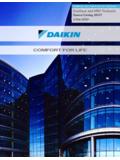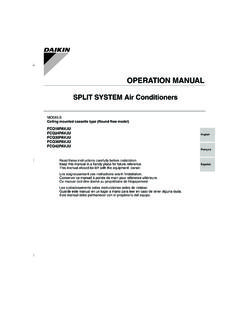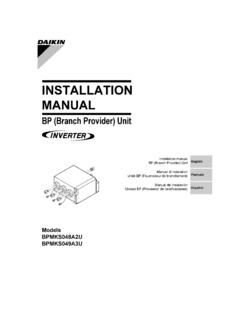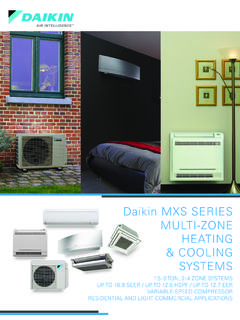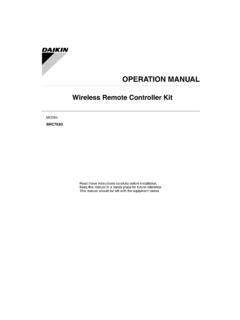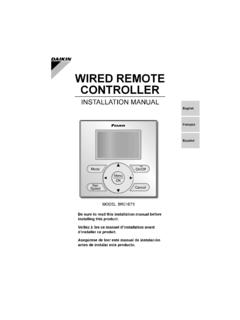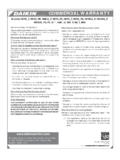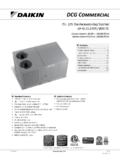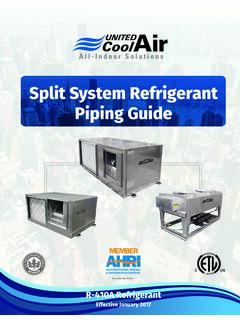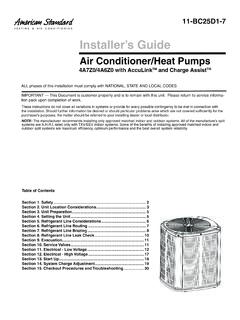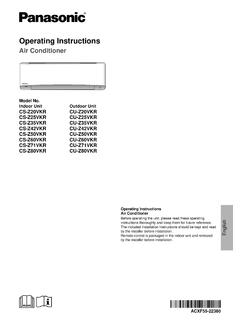Transcription of VRV Reference Guide - Daikin AC
1 VRV Reference GuideDaikin Industries, Ltd. (DIL) is a global Fortune 1000 company which celebrated its 90th anniversary in May 2014. The company is recognized as one of the largest HVAC (Heating, Ventilation, Air Conditioning) manufacturers in the world. DIL is primarily engaged in developing indoor comfort products and refrigeration systems for residential, commercial and industrial applications. Its consistent success is derived, in part, from a focus on innovative, energy-efficient and premium quality indoor climate and comfort management WORLD LEADING M A NUFAC T URER OF HVAC PRODUCTSOPERATINGF O U N D E DIN 1924R E S E A R C H DEVELOPMENT OVER $300 MILLIONOVER 60,0000 Daikin VRV SYSTEMSTHROUGHOUT NORTH AMERICAThe Features of VRV.
2 6 Key Points For Selection .. 8 Capacit y Range & Operating Limits ..12 Nomenclature .. 15 Indoor Unit Range .. 18 Indoor Unit Consideration .. 20 Zoning VRV Systems with DZK .. 24 Heat Pump or Heat Recovery? .. 26 Air Cooled or Water Cooled? ..29 Solutions For Ventilation .. 32 system Zoning ..36 Branch Selector Boxes .. 4 0 Single or Multi BSV Boxes? .. 41 Piping Sizes and Optimization ..4 3 Outdoor Unit Installation Space .. 45 Heat Pump Changeover .. 47 Controls Portfolio .. 52 Local Control Options ..56 Featured Controls .. 57 Codes & Standards .. 59 Tips & Considerations ..60 Future Documents & Data ..61 SystemOverview6 The Features of VRV Features & Benefits to Using VRVA VRV system is similar to a chiller but circulates refrigerant to each zone instead of waterA VRV heat pump system has performance and design attributes similar to a 2 pipe chillerA VRV heat recovery system has performance and design attributes similar to a 4 pipe chiller system Industry Leadership since 1982.
3 VRV is a registered TM 8 development series and 4 generations of VRV technology Scalable project opportunities with modular design Broad coverage of most vertical markets and climates Tested and Rated in accordance with AHRI Std 1230 Individual zone control for Advanced zoning capabilities Can operate up to 64 indoor fan coil units Auto charging function Continuous heating during defrost operation Flexible piping limitations to meet a variety of building needs Excellent energy efficiency, especially at part load conditions (IEER) Daikin s optimized scroll compressor designed for R-410A provides a quiet, reliable energy-efficient operation Anti-corrosion treatment standard on exterior metal parts and heat exchanger Fully compatible with the complete Daikin control suite including iTC, and iTM Tie in to open protocol Building Automation systems through LonWorks and BACnet gateways 10-Year Limited Parts Warranty** Complete warranty details are available from your local Daikin manufacturer s representative or distributor or online at Ratings6 8 10 12 14 16 18 20 22 24 26 28 30 32 34 36 38 Nominal Capacity (Ton)2826242220181614121030 IEER (Integrated Energy Efficiency Ratio) VRV IV HP VRV IV HRASHRAE 20107 The Features of VRV (cont.)
4 The benefits of VRV equipment can categorized three core features:From controlling temperature in individual areas to the remote monitoring and control of multiple sites, the Daikin VRV system has a wealth of propriety control options to cover all end user requirements and ensuring exceptional levels of comfort UnitWireless unit ControllerIndoor UnitsRoom or Group ControllerPipingCentral ControllerControlsBMS InterfaceUltra-High Energy EfficienciesExceptional Comfort controlDirect expansion systems (those that use refrigerant to directly condition the space) provide an extremely efficient method of heat controlled com-pressors also ensure optimized system refrigerant & system control sees Daikin VRV far exceed industry energy efficiency ease of both design and installation has been a major factor in the success of VRV in the global market.
5 Simple methodology sees VRV regularly utilized in all project sizes from 3 ton to several 1,000 Modular DesignSPECIFICATIONS& ACCESSORIESSYSTEM OVERVIEWSYSTEM SELECTIONDESIGN OPTIMIZATIONCONTROLS AND STANDARDS8A fully optimized design can realize a number of benefits: Cheaper equipment & installations costs Less outdoor unit footprint A more energy efficient system Far better control of room temperature A significant increase in the probability of winning a projectKey Points for SelectionSystem Diversity vs Connection RatioPEAK LoadIndoor units should be sized to deliver the PE AK loads (total and/or sensible) of the area it is to serve, at the entering air design conditions determined by the building load calculationsBLOCK LoadOutdoor units should be selected to meet the BLOCK Cooling & Heating capacities (The Maximum Load demand of all at tached indoor units at a given time of day)
6 Determined by the same LOAD CalculationsOptimizing VRV system Selection The most successful users of VRV equipment understand the importance of a fully optimized design A key factor that ensures optimized VRV equipment selection is to understand the correlation between system DIVERSITY & CONNECTION RATIOPeak Loads & Block LoadsThe first step to optimization is to understand the different load demands of the equipment to be selected:9 Diversity & Connection Ratio - What s the Difference?Connection Ratio: Both indoor & outdoor units have a Capacity Index number ( FXMQ30 PBVJU indoor unit & RXYQ192 TTJU outdoor unit) Total sum of IDU index numbers ODU index number=CONNECTION RATIO This ratio is defined as a percentage: Example: 8 x FXMQ30P connected to 1 x RXYQ192T = 240 / 192 = Therefore the Connection Ratio = 125% system Diversity:DIVERSITY is the difference between the Maximum system Load demand and the Maximum Capacity of the outdoor unit, at design conditions The VRVX press tool can define diversity - also as a percentageExample: 8 x FXMQ30P connected to 1 x RXYQ168T Maximum Load required at any given time.
7 170,269 btu Maximum Capacity of the ODU at design conditions: ..166,315 btu VRV defines the DIVERSITY of the system at: ..-2% In this example, if the maximum load is called for, the outdoor unit will fall short of demand by 3,954btu This VRV design has a 2% system diversity To summarize: Connection Ratio does NOT indicate the diversity of a VRV system . Use of the VRVX press selection tool will indicate clearly if selected equipment has a system diversity or ACCESSORIESSYSTEM OVERVIEWSYSTEM SELECTIONDESIGN OPTIMIZATIONCONTROLS AND STANDARDS10 Before selection of any VRV system , a minimum amount of information is required for accurate equipment selection and to apply an optimized designFor an accurate selection of indoor units the following information is required:For an accurate selection of outdoor units the following information is required.
8 The dry & wet bulb temperatures entering the coil Engineers will usually provide both Total & Sensible loads which should be entered However it is possible to select equipment using only Total or Sensible load Required when either Heating is the dominant operation or the heating design condition is below 32 F Also known as air-on or mixed air conditions Nominal conditions are typically 80 F db & 67 F wb but rarely reflect actual conditions Design air-on can also be given as db/RH% ( 74 F & 50% RH)The design ambient temperature for the location of the projectThe estimated distance between the outdoor unit and the furthest indoor unit Both engineers and D&B contractors should have this information If this information is not at hand then use ASHRAE standard design conditions for the location This is the linear length from one point to another NOT the total amount of piping Both engineers and D&B contractors should be able to pin point the outdoor unit location Be sure to also establish whether there is any vertical height between outdoor & indoor unitsKey Points for Selection (cont.)
9 Obtain Project Data11 SPECIFICATIONS& ACCESSORIESSYSTEM OVERVIEWSYSTEM SELECTIONDESIGN OPTIMIZATIONCONTROLS AND STANDARDST hinking VRV is just a big multi split DX systemVRV is a chiller circulating refrigerant instead of waterIt s a Zoning system thus an Indoor unit in E VERY roomDesign VRV systems using same approach as VAV or WSHPVRV is a Ductless system More than 55% of units used in Nor th America are Ducted t ypes!Upgrade Indoor Units to the nex t capacity sizeUse accurate load calc values and trust selection softwareOptimum selection of Controls is not impor tantBe knowledgeable on controls capabilities minimize BAS or even elimination of BAS is of ten possibleThe entire application needs to be VRVUse VRV where it makes sense for the customer & projectVRV system Selection - Avoid the common pitfallsVRV IV Heat Pump & Heat Recovery, Aurora SeriesVRV-IV W-SeriesVRV-SSystem LimitsFXDQ, FXMQ_P, FXAQAll other modelsAll Indoor UnitsSingle 200% 200%130%130%Dual Module 160%N/ATriple Module130%N/A On VRV-III, if systems operated >130% indoor unit thermo-ON, all FCU were set to low fan speed.
10 On VRV IV this function can now be overridden at commissioning stage For FXFQ 07, 09 models, connection ratio is limited to 130%Indoor Unit Size07091215182430364248547296 Indoor Unit Capacity Range & Operating LimitsODU Capacity Range & Piping LimitationsOutdoor Unit RangeAurora Series & 575V Capacity MBH ( Tn)VoltageType# of Modules# of CompressorsMax. # IDU136 (3)1/208- 230/60 HzHEAT PUMP11648 (4)860 (5)1072 (6)3/208-230V/60Hz3/460V/60 HzHEAT RECOVERY111296 (8)216120 (10)20144 (12)225168 (14)29192 (16)22333216 (18)437240 (20)41264 (2 2)345288 (24)449312 (26)54336 (28)58360 (30)333662384 (32)464408 (34)5644 32 (36)64456 (38)64 CapacityVoltageType# of Modules# of CompressorsMax. # IDU72 (6)3/208-230V/60Hz3/460V/60 HzUnifiedHP or HR111284 (7)1114144 (12)2224168 (14)2229216 (18)333625 2 (21)3336 Capacity MBH ( Tn)Voltage# of Modules / Compressors2 Max.
